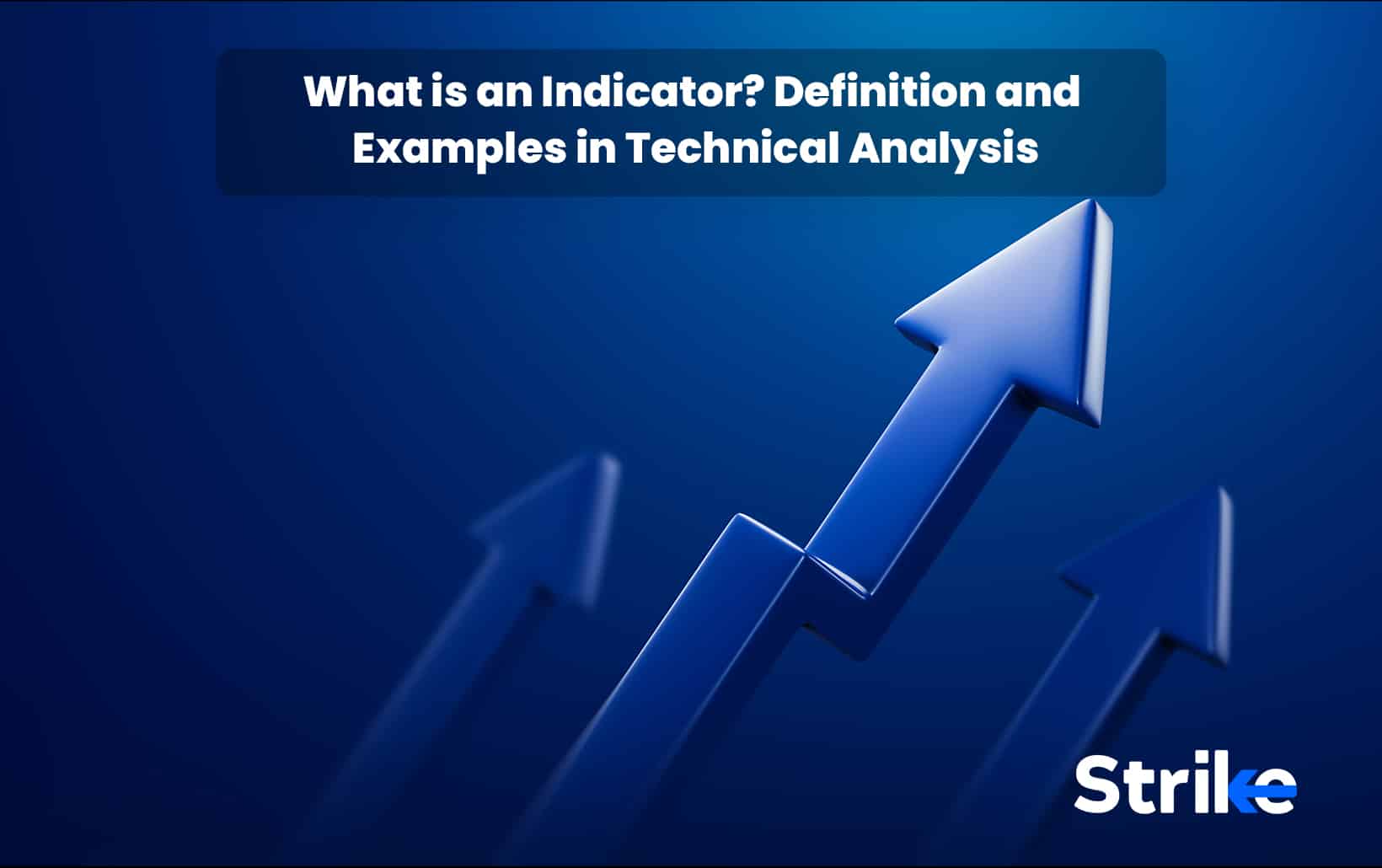
An indicator denotes a mathematical calculation or statistical measurement used to analyze and interpret market data to identify potential trends. Indicators are eye-openers that help in understanding market trends and getting an idea of supply and demand. Indicators are classified into two different groups: economic indicators and technical indicators.
Economic indicators help in studying the growth or contraction of the economy as a whole. Technical indicators help predict changes in stock trends or price patterns. The accumulation/distribution line occupies a prominent position among the seven best indicators used. There are different types of indicators available. Each Indicator is different in its own way. They have their own methodology and purpose. The common types of indicators used to analyze stock market trends include Trend-following indicators that help identify the direction and strength of a prevailing trend in the market.
Oscillators are indicators that oscillate between fixed levels, indicating overbought or oversold conditions in the market. Volume-based indicators focus on analyzing trading volume to gauge market activity and the strength of price movements. Volatility indicators measure the rate and extent of price fluctuations. This article accounts for the different types of indicators, benefits, limitations, and many more on the topic.
What does an Indicator mean in Technical Analysis?
An indicator denotes a mathematical calculation or statistical measurement used to analyze and interpret market data to identify potential trends when it comes to technical analysis. They are often displayed as overlays on price charts or as separate charts below the main price chart. They provide traders and analysts with additional insights into market conditions and help in decision-making.
Mathematical formulas and algorithms are the base of indicators. Traders predict future price movements and identify buying or selling opportunities through this indicator analysis. There are two categories of indicators: economic indicators and technical indicators.
What is the other term for Indicator in Technical Analysis?
Another commonly used term for an indicator in technical analysis is “technical indicator.” They help to predict changes in stock trends or price patterns with the help of mathematical formulas and calculations. The analysis using mathematical equations and formulas led to the name technical analysis.
How does an Indicator work in Technical Analysis?
Indicators in technical analysis work by applying mathematical formulas. The values are plotted on charts to provide visual representations of market trends, patterns, and signals. The indicator’s work depends on five basic steps.
1. Data Input: Indicators require input data (usually historical price data, such as open, high, low, or closing prices).
2. Calculation: Mathematical formulas and algorithms help in the calculations. The formula depends on the type of Indicator used in the analysis.
3. Plotting: Plotting a chart (overlay) with the calculated values on a price chart. This visual representation helps traders analyze the relationship between the Indicator and price movements.
4. Interpretation: Traders analyze the indicator values to gain insights into market conditions. It helps in understanding whether it is a bullish signal or a bearish signal.
5. Confirmation and Decision-Making: Indicators are used in conjunction with other technical analysis tools, such as support and resistance levels, chart patterns, or trend lines, to confirm trading signals.
Traders often combine multiple indicators or use them alongside fundamental analysis to increase the probability of making successful trading decisions.
What is the importance of Indicators in Technical Analysis?
Indicators are important in technical analysis by providing traders and analysts with valuable insights into market trends, price patterns, momentum, and potential trading opportunities. Indicators play a crucial role in technical analysis and are important for the following seven reasons.
Indicators help traders identify and confirm market trends. Trend-following indicators provide insights into the direction and strength of a trend. Indicators generate signals that indicate potential entry or exit points for trades. Indicators act as a confirmation tool for other technical analysis patterns and signals. Volatility indicators provide insights into market volatility levels.
High volatility presents more significant trading opportunities, while low volatility indicates a more stable market environment. Indicators assist in risk management by providing traders with information about potential stop-loss levels or profit targets. Indicators are customized and tailored to suit individual trading preferences and styles. Indicators provide visual representations of market data, making it easier for traders to interpret and analyze information.
Proper interpretation, understanding, and validation of indicators are essential for effective use in technical analysis.
What is the role of the Indicator in Technical Analysis?
The role of indicators in technical analysis is to assist traders and analysts in interpreting market data and making informed trading decisions. The six key roles that indicators play in technical analysis are as follows:
Indicators help identify and analyze market trends. They provide insights into the direction, strength, and duration of trends, whether they are bullish, bearish, or ranging.
Indicators generate signals that indicate potential entry or exit points for trades. Traders use these signals to time their trades more effectively.
Indicators assist in risk management by providing traders with insights into potential stop-loss levels or profit targets.
Indicators that measure volatility, such as Bollinger Bands or the Average True Range (ATR), help traders assess the level of market volatility. This information is valuable for adjusting position sizes, setting stop-loss orders, or determining profit targets.
Indicators act as a confirmation tool for other technical analysis patterns and signals. Confirmation helps traders validate their trading decisions and increase the probability of successful trades.
Traders adjust indicator parameters, timeframes, or combinations to align with their trading strategies. This customization allows traders to adapt to changing market dynamics and enhance the effectiveness of their analysis.
The indicators are tools that provide additional information and should be used alongside other forms of analysis, such as chart patterns, support and resistance levels, and fundamental analysis, to gain a comprehensive understanding of the market. Traders should also consider the limitations and potential drawbacks of indicators and validate their signals through additional analysis.
What are the different types of Indicators?
Indicators are the tools that help identify the market. There are seven common categories of indicators used in technical analysis.
1. Trend-following indicators
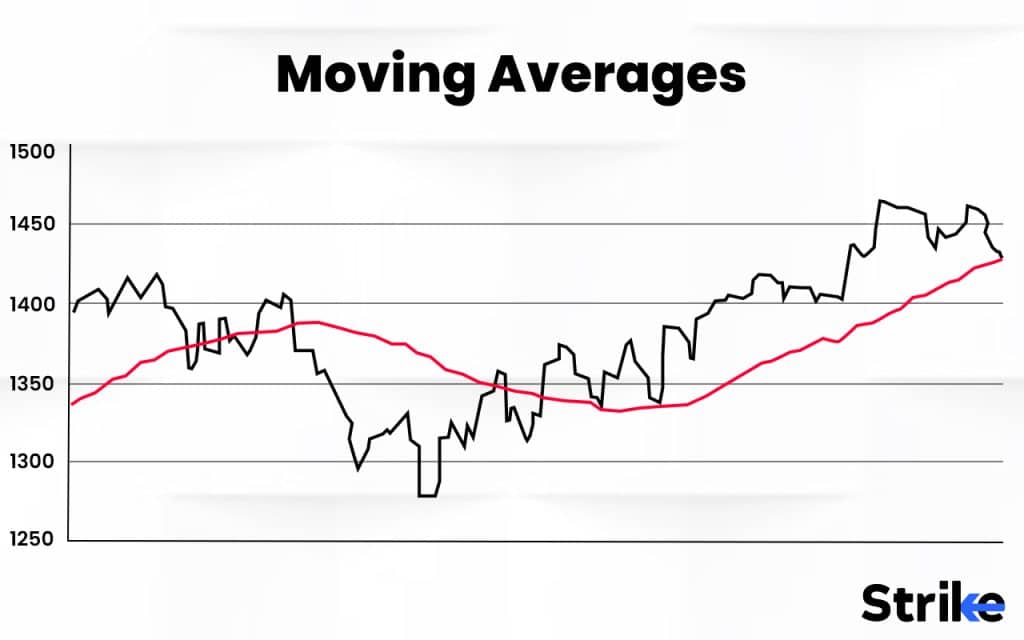
They are used to identify and confirm the direction and strength of market trends. They help determine whether the market is in an uptrend, a downtrend, or a ranging phase. Example: Moving Averages.
2. Oscillators
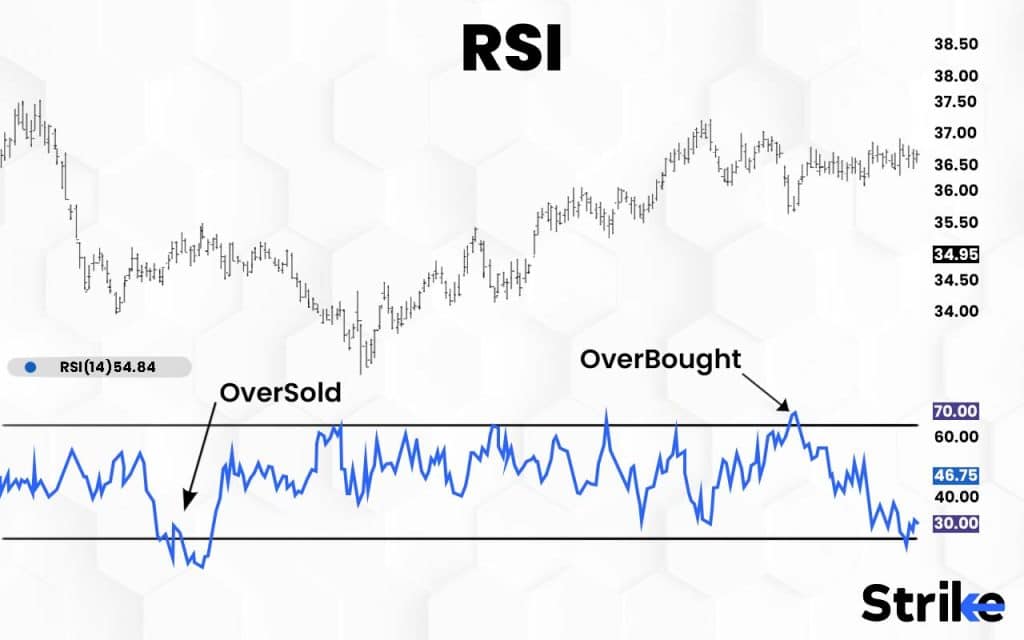
Oscillators are indicators that oscillate between fixed levels, indicating overbought or oversold conditions in the market. They are used to identify potential reversal points or divergences between the price and the oscillator readings. Example: Relative Strength Index (RSI).
3. Volume-based indicators
These indicators analyze trading volume to gauge market activity and the strength of price movements. They help traders assess the participation and enthusiasm of market participants. Example: On-Balance Volume (OBV).
4. Momentum indicators
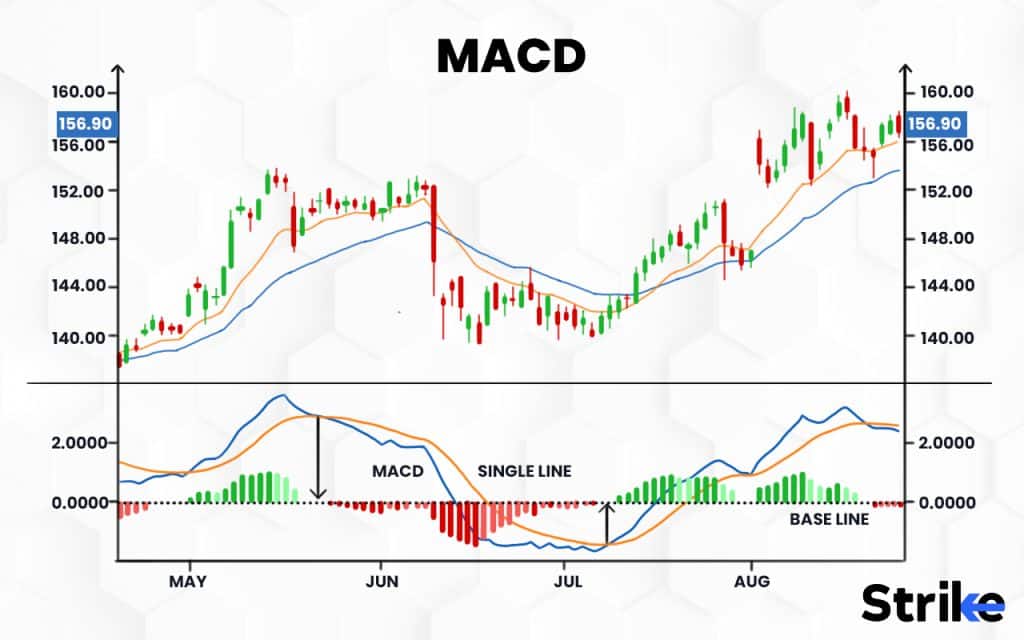
These indicators assess the speed and magnitude of price movements. They help traders identify the strength or weakness of price momentum, which indicates potential trend continuation or reversal. Example: Moving Average Convergence Divergence (MACD).
5. Support and resistance indicators
These indicators identify key support and resistance levels in the market. They help traders determine potential areas where the price is likely to reverse or encounter obstacles. Example: Pivot Points.
6. Volatility indicators
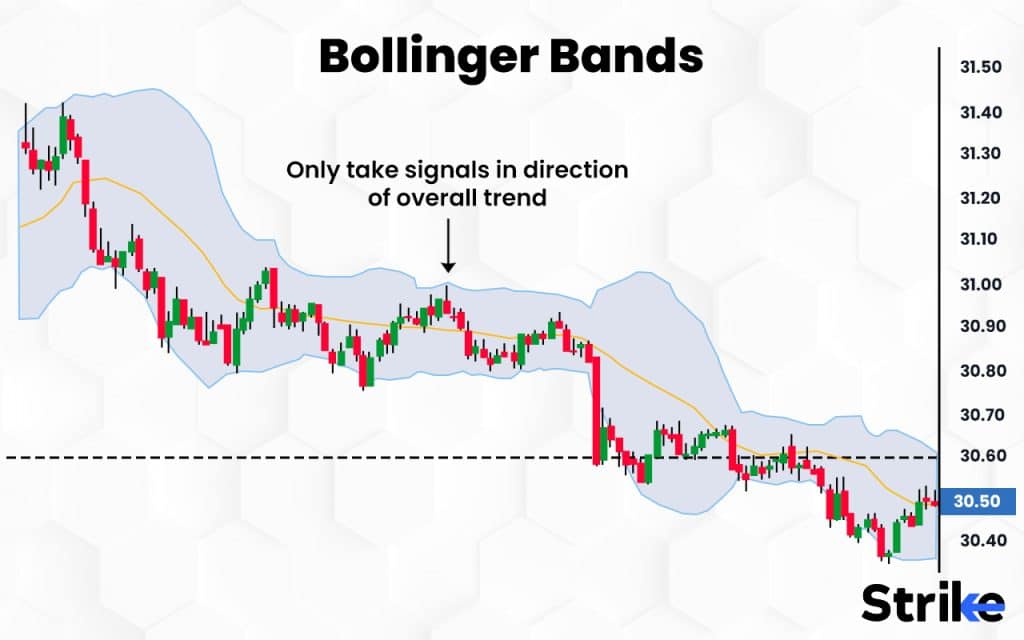
Volatility indicators measure the rate and extent of price fluctuations. They help traders identify periods of high or low volatility, which assist in adjusting trading strategies. Example: Bollinger Bands.
7. Cycle indicators
Cycle indicators help identify recurring patterns and cycles in price movements. Example: Elliot Wave Oscillator.
Traders often use a combination of indicators from different categories to gain a comprehensive view of the market and validate their trading decisions. The choice of indicators depends on the trader’s trading style, preferences, and the specific characteristics of the market.
How do you choose the right Indicators for a specific market or trading strategy?
Choosing the right indicators for a specific market or trading strategy requires careful consideration and analysis. Start by understanding your trading strategy and the specific requirements it entails. Different strategies require different indicators to suit their objectives. Clearly define what you want to achieve with your indicators. It helps to narrow down the types of indicators that align with your objectives.
Familiarise yourself with the different categories of indicators and understand how each category works. Evaluate the characteristics of the market or asset you are trading. Consider the volatility, liquidity, and overall behavior of the market when selecting indicators. Narrow the list of indicators and test them thoroughly. Backtesting helps you assess the effectiveness and reliability of the indicators within your chosen trading strategy.
Consider combining multiple indicators to gain a more comprehensive view of the market. Look for indicators that complement each other and provide different perspectives. Avoid using too many indicators or indicators with complex calculations. Excessive indicators lead to confusion and conflicting signals. Market conditions and trading strategies evolve over time, so staying flexible and open to modifications is important.
The indicators should be used in conjunction with other forms of analysis, such as chart patterns, support and resistance levels, and fundamental analysis, to gain a more holistic understanding of the market.
Can you combine Technical Indicators with other forms of analysis?
Yes. Combining technical indicators with other forms of analysis provides a more comprehensive and well-rounded view of the market. Fundamental analysis involves assessing assets based on economic and financial factors. The combination of technical indicators with fundamental analysis helps in gaining a broader perspective on the market.
The key is to use these different analysis methods to complement and validate each other. Each method brings unique insights to the table, and combining them provides a more robust foundation for your trading decisions.
What is the fastest-leading Indicator?
It is not possible to identify any one indicator as the fastest-leading Indicator. Indicators provide more immediate or early signals of potential price movements.
Does the Indicator refer to Technical Chart Patterns?
No, technical indicators and technical chart patterns represent different concepts. While technical indicators consist of mathematical calculations based on historical price and volume data, focusing on market trends, momentum, volatility, and other price behavior aspects, technical chart patterns differ significantly. Technical chart patterns are formed by the graphical representation of price movements in a chart and are used to identify trading signals and potential market trends. They include formations like head and shoulders, triangles, flags, and more, each offering unique insights that complement the analytical power of technical indicators.
What are the Benefits of Indicators in Technical Analysis?
Indicators play a crucial role in technical analysis by providing traders and analysts with valuable information about market trends, price momentum, volatility, and potential trading opportunities. Indicators offer six major benefits in technical analysis. They are as follows.
1. Price and Market Insight
Indicators provide valuable insights into price trends, momentum, volatility, and other market dynamics.
2. Objective Analysis
Indicators depend on mathematical calculations and predefined rules, which help remove subjective biases from the analysis process. They provide objective criteria for assessing market conditions and generating trading signals.
3. Confirmation of Analysis
Indicators act as a confirmation tool for other forms of technical analysis. It leads to confident trading decisions.
4. Timing of Entry and Exit Points
Indicators assist traders in identifying optimal entry and exit points for trades. Indicators help in understanding the right time to use them and increase the probability of entering or exiting trades at favorable prices.
5. Risk Management
Indicators help traders manage risk by providing insights into potential market reversals or the strength of price trends.
6. Customization and Adaptability
Indicators are customized to suit individual trading styles and strategies. Traders adjust the parameters, timeframes, or combinations of indicators to align with their specific needs.
It’s important to note that while indicators offer benefits, they also have limitations. It’s essential to use indicators as part of a comprehensive analysis and consider factors such as market conditions, fundamental analysis, and risk management principles.
What are the Limitations of Indicators in Technical Analysis?
Indicators are a valuable tool in technical analysis. They help in understanding the market structure. They have the following five limitations.
1. Lagging Nature
Most indicators depend on historical price data, which means they reflect past price movements. They won’t be able to capture real-time market conditions accurately.
2. False Signals
Indicators are not infallible. They generate false or misleading signals. These false signals lead to losses or missed trading opportunities. Traders should employ additional analysis and risk management techniques to confirm signals and minimize the impact of false readings.
3. Market Adaptability
Indicators are designed based on specific assumptions and market conditions.
4. Subjectivity in Interpretation
Traders have different preferences or biases in interpreting indicator signals, leading to varied trading decisions. It’s important to establish clear rules and guidelines for interpreting indicators and to ensure consistency in their application.
5. Over-Reliance and Complexity
Traders fall into the trap of over-relying on indicators, using too many indicators simultaneously, or applying complex combinations of indicators.
To overcome these limitations, it’s crucial to use indicators as part of a holistic approach to technical analysis. Combining indicators with other forms of analysis, such as chart patterns, support and resistance levels, volume analysis, or fundamental analysis, helps overcome these limitations.
Is it hard to learn about Indicators?
No. The difficulty level of learning about indicators in technical analysis varies depending on factors, including your background knowledge, mathematical aptitude, and level of dedication to learning.
Is trading with Indicators for beginners only?
No, trading with indicators is not limited to beginners. Traders of all experience levels, including beginners, intermediate traders, and even professionals, utilize indicators as part of their trading strategies. It provides valuable insights into market conditions and is a useful tool for making trading decisions. Indicators provide a structured approach and help in analyzing markets and identifying potential trading opportunities for beginners.








![85 Common Stock Market Terminologies for Dummies [Updated List for 2026] 52 85 Common Stock Market Terminologies for Dummies [Updated List for 2025]](https://www.strike.money/wp-content/uploads/2025/04/Popular-Stock-Market-Terms-for-Beginners-Banner.png)










No Comments Yet.